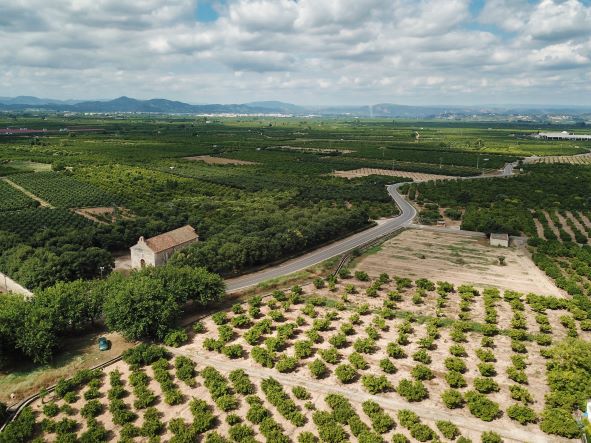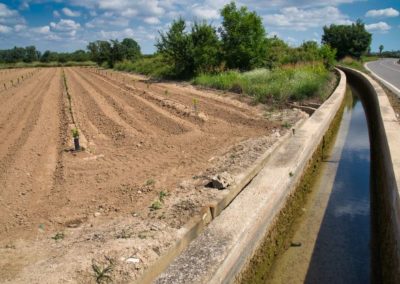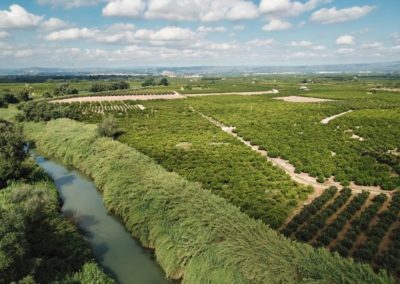Citriculture in Ribera del Júcar
DOI: 10.5281/zenodo.7607955
Inland and Coastal Countryside and Plains Model
Author: Emilio Barba Campos
Overview of SAMUTER
The SAMUTER of citriculture analyses the current situation of the citrus cultivation system, mainly orange trees, in the Valencian Community, taking as an example a territorial sector of the Ribera Alta del Júcar region, with the nerve centre in the municipality of Carcaixent. This municipality is known as “the cradle of the orange”. The territorial delimitation of this citrus-growing Samuter includes seven municipalities in this region; the differentiating criterion is the significance and importance of orange growing in them: L’Alcudia, Alginet, Algemesí, Alzira, Carcaixent, Carlet and Guadassuar. The different aspects related to production and marketing are analysed, as well as the socio-cultural implications and heritage elements related to this crop.
1. Environmental sustainability
SAMUTER includes seven municipalities in the Ribera Alta region, where irrigated citrus crops have been predominant in relation to other crops. In the last half century, it has reached 60% of the total cultivated area.
The selected territory retains, in general, a good landscape quality, which includes a variety of structures that fit in with the agricultural scene: an extensive network of irrigation ditches, a large number of paths connecting the different fields, and the presence of traditional farmhouses, as well as waterwheels and wells. The massive predominance of orange groves means that the visual impression is good, but, on the contrary, the agrodiversity is low, in contrast to other SAMUTERs in the Valencian Community, as is the case in the Huerta de Valencia. We would also highlight, as a positive aspect, that the Ribera Alta region concentrates most of the companies involved in the transformation of organic stability; there is a certified area of organic agriculture of some 475 hectares at present.
The municipalities included in SAMUTER are not home to many environmental protection figures, and none of them has state recognition. Only Alzira and Carcaixent are home to two Municipal Nature Reserves (a figure of regional protection). There are also areas included in various Natura 2000 Network sites (SCI, SAC, SPA), but the presence of orange groves in these areas is very marginal.
2. Territoriality and agri-environmental policies
La Ribera Alta is located in the centre of the province of Valencia, in the central sector of the Valencian Community. Es una de las comarcas del piedemonte valenciano, que representan la transición entre las tierras bajas litorales y las zonas de montaña de la parte interior. It covers an area of 970 km2 and is made up of 35 municipalities of different sizes, seven of which are included in SAMUTER due to the importance of citrus fruits: L’Alcudia, Alginet, Algemesí, Alzira, Carcaixent, Carlet and Guadassuar.
In the mid-19th century, until 1850, the main focus of orange tree production was limited to the lands between the municipalities of Alzira and Carcaixent; these were mainly plantations put into production by large agronomist landowners who tended to have other professions of renown for the time. At the end of the 19th century, orange plantations multiplied into hundreds of orchards, and a whole network of railways and associated infrastructures were created, with large warehouses being built for oranges and fertilisers, and activities such as sawmills for wood for packaging, paper mills and mechanical workshops for the repair of irrigation machinery flourished. In the 20th century, the agricultural area under citrus fruits in La Ribera increased from 7,900 ha in 1920 to more than double in just 10 years. This expansion was cut short by the Spanish and European wars, and recovery began in the 1950s. At the end of the 20th century, market saturation began to be detected, and in some areas orange growing began to be abandoned in favour of stone fruit and persimmon cultivation.
3. Relations between production, processing, marketing and consumption
The structure of the property and the features of the plots of land reflect the social organisation that underpins it, and certain infrastructures of different types linked to the rural organisation of the place still survive today. For example, the traditional Art Nouveau country houses where farmers once lived, representing the characteristic way of life of the time associated with the fields, have been preserved. In addition to its productive activity as an agricultural space, it currently performs different types of functions, such as recreational or social, and provides green and open spaces for the enjoyment of the community. In recent years, it has expanded more into exporting the product to different parts of Spain and Europe through the numerous cooperatives in the area.
4. Good governance
The participation of local societies in the development, maintenance and wellbeing of the orange grove landscape through the grouping of agri-food cooperatives has been noted. The origin of this teamwork dates back to the 19th century and is currently maintained in order to deal with problems such as the rise in the price of supplies. Cooperativism unites the most agricultural practices with the food industry, which can be easily seen in the turnover figures for this area, which has helped to boost its economy. It should also be added that numerous cooperatives in La Ribera Alta such as Agrícola Alginet, S.Coop.V., SAT 9923 Exportaciones Heretat, R.L. (Cofrutas), Coop. Agr. S.C.J. Coop. V. (COPAL), Frutas Carrusel, S.L., etc. have the IGP Valencia Citrus seal which certifies that citrus from the area meets the requirements for guaranteeing origin and quality. Ninety percent of these cooperatives are associated with a second level cooperative, which means that the degree of integration between cooperatives is very high. Moreover, the system as such does not benefit from specific protection measures..





Recent Comments